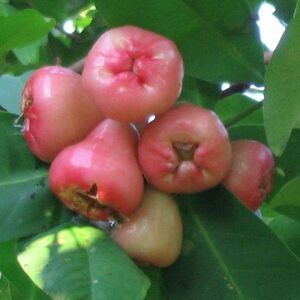
Rose apples
Name Variations[]
- wax apple
- Otaheiti Apple
- Jambakka
About rose apple[]
- Syzygium samarangense from Wikipedia
Rose apples in no way resemble roses or apples.[1] In fact, it is considered a minor fruit. The rose apple tree is used more for its fuel than for its fruit. It is a tropical tree growing to 12 m tall, with evergreen leaves 10–25 cm long and 5–10 cm broad. The flowers are white, 2.5 cm diameter, with four petals and numerous stamens. The fruit is a bell-shaped edible berry, with colors ranging from white, pale green, green, red, purple, crimson, to deep purple or even black, 4–6 cm long in wild plants. The flowers and resulting fruit are not limited to the axils of the leaves and can appear on nearly any point on the surface of the trunk and branches. When mature, the tree is considered a heavy bearer. Syzygium samarangense (syn. Eugenia javanica) is a species in the Myrtaceae, native to Philippines, India, Indonesia and Malaysia.
Common names include wax apple, love apple, java apple, chomphu (in Thai), Mận (in Vietnam), Ohtahiti Apple (in Jamaica), water apple, mountain apple, jambu air ("water guava" in Malay), wax jambu, bell fruit, makopa, tambis (Philippines), and chambekka in Malayalam, jamrul (in Bengali), and jumbu (Sri Lanka). It is known as jamalac in French, and zamalac in the French-based creole languages of Mauritius, Réunion, Seychelles and other Indian ocean islands. On Curaçao, Netherlands Antilles, the fruit is called kashu Sürnam in Papiamentu, which means ‘cashew from Surinam’, while in Surinam the fruit is called curaçaose appel (‘apple from Curaçao’ in Dutch). In Trinidad and Tobago it is known as pommerac, while in the Dominican Republic a small sub-species of the wax apple is known as cajuilito, or small cashew. In the Pacific Islands, this fruit is known as Mountain Apple. In the Fiji Islands it is common in the outskirts of forests. Called "Kavika" in Fiji, it is well-documented as a medicinal plant (particularly the bark of the Kavika tree). In Saint Kitts and Nevis it is commonly known as "morroca," a corruption of Morroco, from where the plant was imported to St. Kitts in colonial days. In Taiwan and China, it is known by a phonetic approximation "lian wu" (simplified Chinese: 莲雾; traditional Chinese: 蓮霧; pinyin: lián wù; POJ: lián-bū or lembu).
Flavor and uses[]
The fruit has a crunchy texture, which is sweet and very juicy, and it has nothing similar to an apple except for its color. The color of its juice is purple. The fruit's pith is like cotton. As well as in its native range, it is also cultivated in tropical regions such as Vietnam, Taiwan, Thailand, Philippines, Bangladesh, Pakistan and India. A number of cultivars with larger fruit have been selected. In general, the paler or darker the color is, the sweeter it is. In South East Asia, the black ones are nicknamed "Black Pearl" or "Black Diamond," while the very pale greenish white ones are called "Pearl." They are among the highest priced ones in fruit markets.
When choosing a good wax apple, look for ones with the bottom segments closed up because open holes signify worm eggs inside the fruit. Also, usually the reddest fruits are the sweetest. To eat, the core is removed and the fruit is served uncut, in order to preserve the unique bell shape presentation. It is usually eaten fresh but sometimes canned in a simple syrup with cinnamon.
